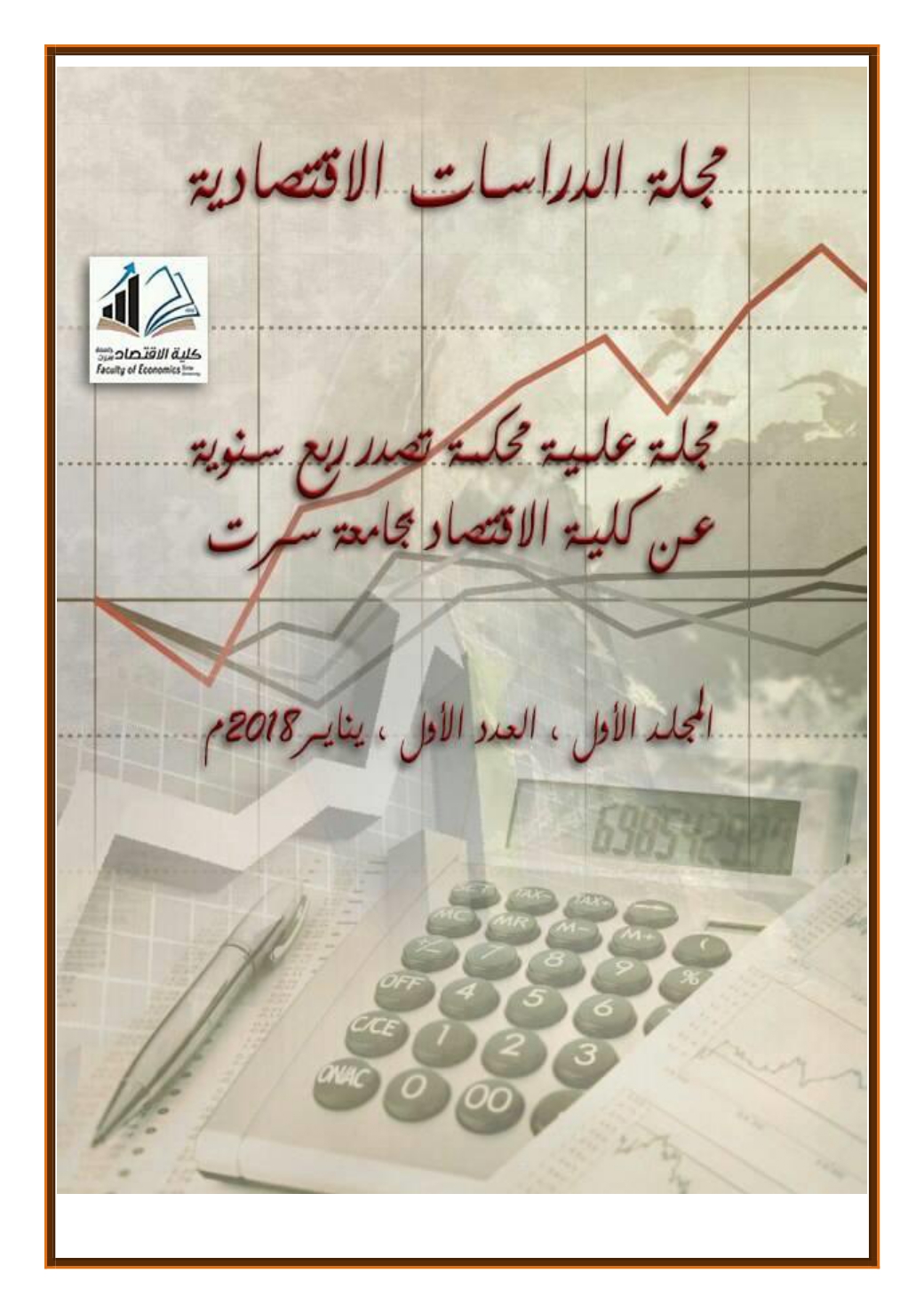مقومات تطبيق بطاقة الأداء المتوازن كأداة للتخطيط الاستراتيجي في المشروعات الليبية الصغيرة
DOI:
https://doi.org/10.37375/esj.v1i1.1960الكلمات المفتاحية:
التخطيط الاستراتيجي، بطاقة الأداء المتوازن، المشروعات الصغيرةالملخص
تهدف هذه الدراسة إلى التعرف على توافر مقومات تطبيق بطاقة الأداء المتوازن كأداة للتخطيط الاستراتيجي فى المشروعات الليبية الصغيرة، لتحقيق الهدف من الدراسة تم تصميم استمارة استبيان وزعت على عينة الدراسة، وتم تطبيق الأسلوب الاحصائي الوصفي و الاستدلالي لتحليل بيانات الدراسة مثل المتوسط و الانحراف المعياري وبعض الاختبارات الإحصائية، وخلصت الدراسة إلى أن المشروعات الليبية الصغيرة لديها مقومات تطبيق بطاقة الأداء المتوازن كأداة للتخطيط الاستراتيجي.
المراجع
أبو قمر، محمد أحمد محمد ( 2009 ) "تقويم أداء بنك فلسطين المحدود باستخدام بطاقة قياس الأداء المتوازن" الجامعة الإسلامية غزة، عمادة الدراسات العليا، كلية التجارة، قسم المحاسبة والتمويل، رسالة ماجستير غير منشورة.
بوزيان، جوهر ( 2010 ) واقع التخطيط الاستراتيجي فى المؤسسات الصغيرة و المتوسطة فى الجزائر، رسالة ماجستير غير منشورة فى علوم التسيير، جامعة قصدي مرباح الجزائر.
الحبوني، إدريس عبد الجواد إدريس ( 2014 ) استخدام مدخل الأداء المتوازن في قياس جودة أداء الجامعات في ليبيا (دراسة تطبيقية على جامعة بنغازي)، المؤتمر العربي الدولي الرابع لضمان جودة التعليم العالي /3-1 IACQA أبريل 2014 ، جامعة الزرقاء، الأردن.
الذيبة، زياد عبد الحليم (2011) مدى تطبيق النظام المتوازن الأداء ( BSC ) في المصارف التجارية اليمنية: دراسة تطبيقية، أبحاث اقتصادية و إدارية، العدد التاسع، 139-168.
الرفاتي، عادل جواد (2011) مدى قدرة المنظمات الأهلية الصحية بقطاع غزة (BSC) على تطبيق بطاقة الأداء المتوازن كأداة لتقويم الأداء التمويلي، رسالة ماجستير غير منشورة، كلية التجارة، الجامعة الإسلامية بغزة.
عبد اللطيف، عبد اللطيف و حنان تركمان (2005) الرقابة الاستراتيجية و آثارها على زيادة فاعلية أداء المنظمات، مجلة جامعة تشرين للدراسات و البحوث العلمية، سلسلة العلوم الاقتصادية و القانونية، جامعة تشرين، المجلد 27 العدد 127
عوجه، أزهار مراد (2010 ) العلاقة بتُ بطاقة الأداء المتوازن وإدارة الجودة الشاملة وأثرها في القيمة المستدامة للمنظمة: دراسة تطبيقية في الشركة الوطنية لإنتاج المشروبات الغازية – الكوفة، رسالة ماجستير غير منشورة، كلية الإدارة والاقتصاد - جامعة الكوفة العراق.
الغريب، أبو عجيلة رمضان عثمان(2012) مدى إمكانية استخدام بطاقة الأداء المتوازن لتقييم أداء البنوك التجارية الليبية )جامعة الشرق الأوسط، كلية الأعمال، قسم المحاسبة، رسالة ماجستير غير منشورة.
الكفراوى، نرمين محمد (2011) تطبيق مدخل التقييم المتوازن للأداء بقطاع الفنادق بمصر ( دراسة ميدانية) رسالة ماجستير غير منشورة قسم إدارة الأعمال، كلية التجارة، جامعة الزقازيق، مصر.
مقابلة، إيهاب و ماهر المحروق (2007 ) "المشروعات الصغيرة و المتوسطة: مفهومها، خصائصها، أهميتها، مقوماتها، معوقاتها"، مؤتمر المشروعات الصغيرة أداة فاعلة لمحاربة الفقر، جامعة اليرموك، الأردن، 29-3—2007.
ملو العين، علاء محمد ( 2015) "استخدام القياس المتوازن للأداء لتقييم خدمات القطاع المصرفي السعودي في ظل حوكمة الأداء الاستراتيجي بالتطبيق على البنوك التجارية السعودية"، دراسات العلوم الإدارية، المجلد 42 ، العدد 1، 307-328.
النجار، جميل (2012) "أثر ( تطبيق بطاقة الأداء المتوازن على تعزيز المركز التنافسي الاستراتيجي دراسة تطبيقية على قطاع المؤسسات المالية العاملة في قطاع غزة"، المؤتمر الاقتصادي لجامعة القدس المفتوحة : نحو تعزيز تنافسية المنتجات الفلسطينية، المنعقد في رام الله – فلسطين16-17/ 10/ 2012.
المراجع الأجنبية :
Atril, P. (2009), Financial Management: For Decision Makers, Essex - England, Pearson Education,Fifth.
Ax, C. and T. Bjørnenak (2007). management accounting innovations: origins and diffusion. issues in management accounting. T. Hopper, D. Northcott and R. W. Scapens. Harlow, Pearson education.
Baruch, Y. (1999), "Response rate in academic studies-A comparative analysis," Human relations 52(4): 421-438.
Baruch, Y. and B. C. Holtom (2008), "Survey response rate levels and trends in organizational research," Human relations 61(8): 1139-1160.
Blumberg, B., D. R. Cooper and P. S. Schindler (2005), Business research methods, London, McGraw-Hill.
Bobillo, F., M. Delgado, J. Go´mez-Romero and E. Lo´pez (2009), "A semantic fuzzy expert system for a fuzzy balanced scorecard," Expert Systems with Applications 36: 423-433.
Creswell, J. W. (2003), Research Design Qualitative, Quantitative and Mixed Methods Approaches, London, SAGE Publications
Easterby-Smith, M., K. Golden-Biddle and K. Locke (2008), "Working with pluralism: Determining quality in qualitative research," Organizational Research Methods 11(3): 419-429.
El-Nakhat, K. A. (2007). Accounting Information in Micro Manufacturing Enterprises in Libya. Sheffield, Accounting Department, Sheffield Hallam University, Unpublished Ph.D thesis.
GAI (2007). Statistics Book. Tripoli, General Authority for Information
Giannopoulos, G., A. Holt, E. Khansalar and S. Cleanthous (2013), "The use of the Balanced Scorecard in small companies," International Journal of Business and Management 8(14): 1.
Gumbus, A. and R. N. Lussier (2006), "Entrepreneurs use a balanced scorecard to translate strategy into performance measures," Journal of Small Business Management 44(3): 407-425.
Hogarth-Scott, S., K. Watson and N. Wilson (1996), "Do small businesses have to practise marketing to survive and grow?," Marketing Intelligence & Planning 14(1): 6-18.
Hopper, T., M. Tsamenyi, S. Uddin and D. Wickramasinghe (2009), "Management accounting in less developed countries: what is known and needs knowing," Accounting, Auditing and Accountability Journal 22(3): 469-514.
Ittner, C. D., D. F. Larcker and T. Randall (2003), "Performance implications of strategic performance measurement in financial services firms," Accounting, Organizations and Society 28(7): 715-741.
Jamil, C. and R. Mohamed (2011), "Performance measurement system (PMS) in small medium enterprises (SMES): A practical modified framework," World Journal of Social Sciences 1(3): 200-212.
Johnson, H. T. and R. S. Kaplan (1987), Relevance Lost: The rise and Fall of Management Accounting, Boston, Harvard Business School Press
Kaplan, R. and D. Norton (1992), "The balanced scorecard - Measures that drive performance," Harvard Business Review 70: 71-79.
a. --- (1995), "Putting the balanced scorecard to work," Performance measurement, management, and appraisal sourcebook: 66.
--- (1996a), The balanced scorecard: translating strategy into action, Boston, Mass., Harvard Business School Press.
--- (1996b), "Linking the balanced scorecard to strategy," California Management Review 39(1): 53-79.
--- (1996c). Using the balanced scorecard as a strategic management system, Harvard business review Boston, MA.
--- (2001a), "Transforming the Balanced Scorecard from Performance Measurement to Strategic Management: Part I," Accounting Horizons 15(1).
--- (2001b), "Transforming the Balanced Scorecard from Performance Measurement to Strategic Management: Part II," Accounting Horizons 15(2): 147-160.
Lancaster, G. and I. Waddelow (1998), "An empirical investigation into the process of strategic marketing planning in SMEs: its attendant problems, and proposals towards a new practical paradigm," Journal of Marketing Management 14(8): 853-878.
Martin, G. and H. Staines (1994), "Managerial competences in small firms," Journal of Management Development 13(7): 23-34.
McCartan-Quinn, D. and D. Carson (2003), "Issues which impact upon marketing in the small firm," Small Business Economics 21(2): 201-213.
McKiernan, P. and C. Morris (1994), "Strategic planning and financial performance in UK SMEs: does formality matter?," British Journal of Management 5(s1): S31-S41.
Nørreklit, H. (2000), "The balance on the balanced scorecard a critical analysis of some of its assumptions," Management Accounting Research 11(1): 65-88
--- (2003), "The Balanced Scorecard: what is the score? A rhetorical analysis of the Balanced Scorecard," Accounting, Organizations and Society 28(3): 591-619.
Nulty, D. D. (2008), "The adequacy of response rates to online and paper surveys: what can be done?," Assessment & evaluation in higher education 33(3): 301-314.
Orpen, C. (1994), "Strategic planning, scanning activities and the financial performance of small firms," Strategic Change 3(1): 45-55.
Pleitner, H. J. (1989), "Strategic behavior in small and medium-sized firms: preliminary considerations," Journal of small business management 27(4): 70-75.
Reid, G. C. (1995), "Early life-cycle behaviour of micro-firms in Scotland," Small Business Economics 7(2): 89-95.
Saunders, M., P. Lewis and A. Thornhill (2007), Research Methods for Business Students, Edinburgh, Person Education Limited
Stangor, C. (1998), Research Methods for the Behavioral Sciences, New York, Houghton Mifflin Co.
Thompson, K. and N. J. Mathys (2008), "The Aligned Balanced Scorecard: An Improved Tool for Building High Performance Organizations," Organizational Dynamics 37(4): 378–393.
Wong-On-Wing, B., L. Guo, W. Li and D. Yang (2007), "Reducing conflict in balanced scorecard evaluations," Accounting, Organizations and Society 32: 363-377
Zoubi, A. and A. Alkizza (2015). The relevance of management accounting: whether lost or regained? 1st Cairo University International Conference on Accounting (CUICA). Cairo Egypt
Zoubi, A. A. M. (2011). The processes of management accounting change in Libyan privatised companies: an institutional perspective. Durham Business School. Durham, Durham University. PhD.




































